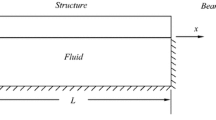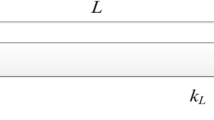Abstract
A simple and accurate mixed modal-differential quadrature formulation is proposed to study the dynamic behavior of beams in contact with fluid. Both free and forced vibration problems are considered. The proposed mixed methodology uses the modal technique for the structural domain while it applies the differential quadrature method (DQM) to the fluid domain. Thus, the governing partial differential equations of the beam and fluid are reduced to a set of ordinary differential equations in time. In the case of forced vibration, the Newmark time integration scheme is employed to solve the resulting system of ordinary differential equations. The proposed formulation, in general, combines the simplicity of the modal method and high accuracy and efficiency of the DQM. Its application is shown by solving some beam-fluid interaction problems. Comparisons with analytical solutions show that the present method is very accurate and reliable. To demonstrate its efficiency, the test problems are also solved using the finite element method (FEM). It is found that the proposed method can produce better accuracy than the FEM using less computational time. The technique presented in this investigation is general and can be used to solve various fluid-structure interaction problems.











Similar content being viewed by others
References
Westergaard HM (1933) Water pressures on dams during earthquakes. Trans Am Soc Civ Eng 98:418–433
Chopra AK (1967) Hydrodynamic pressures on dams during earthquakes. J Eng Mech 93(6):205–223
Chopra AK (1968) Earthquake behavior of reservoir-dam systems. J Eng Mech 94(6):1475–1500
Jones A (1970) Vibration of beams immersed in a liquid. Exp Mech 10(2):84–88
Lee GC, Tsai CS (1991) Time domain analysis of dam-reservoir system, I: exact solution. J Eng Mech 117:1990–2006
Xing JT, Price WG, Pomfret MJ, Yam LH (1997) Natural vibration of a beam-water interaction system. J Sound Vib 199(3):491–512
Sader JE (1998) Frequency response of cantilever beams immersed in viscous fluids with applications to the atomic force microscope. J Appl Phys 84(1):64–76
Zhao S, Xing JT, Price WG (2002) Natural vibration of a flexible beam-water coupled system with a concentrated mass attached at the free end of the beam. Proc Inst Mech Eng M, J Eng Marit Environ 216(2):145–154
Fleischer D, Park S-K (2004) Plane hydroelastic beam vibrations due to uniformly moving one axle vehicle. J Sound Vib 273:585–606
Ryuji E, Nobuyoshi T, Yusuke K, Takeshi G (2006) Eigen-value analysis of elastic beam-fluid coupled system using BEM-FEM combined method. J Struct Eng B 52:133–138
Gosselin F, Païdoussis MP, Misra AK (2007) Stability of a deploying/extruding beam in dense fluid. J Sound Vib 299:123–142
Jin JZ, Xing JT (2007) Transient dynamic analysis of a floating beam-water interaction system excited by the impact of a landing beam. J Sound Vib 303:371–390
Gorman DG, Trendafilova I, Mulholland AJ, Horacek J (2007) Analytical modeling and extraction of the modal behavior of a cantilever beam in fluid interaction. J Sound Vib 308:231–245
Basak S, Raman A (2007) Hydrodynamic coupling between micromechanical beams oscillating in viscous fluids. Phys Fluids 19:017105
Weiss B, Reichel EK, Jakoby B (2008) Modeling of a clamped–clamped beam vibrating in a fluid for viscosity and density sensing regarding compressibility. Sens Actuators A, Phys 143:293–301
Lin W, Qiao N (2008) Vibration and stability of an axially moving beam immersed in fluid. Int J Solids Struct 45(5):1445–1457
Rezazadeh G, Fathalilou M, Shabani R, Tarverdilo S, Talebian S (2009) Dynamic characteristics and forced response of an electrostatically-actuated microbeam subjected to fluid loading. Microsyst Technol 15:1355–1363
Qiu L-C (2009) Modeling and simulation of transient responses of a flexible beam floating in finite depth water under moving loads. Appl Math Model 33:1620–1632
Miquel B, Bouaanani N (2011) Practical dynamic analysis of structures laterally vibrating in contact with water. Comput Struct 89(23–24):2195–2210
Shabani R, Hatami H, Golzar FG, Tariverdilo S, Rezazadeh G (2013) Coupled vibration of a cantilever micro-beam submerged in a bounded incompressible fluid domain. Acta Mech 224(4):841–850
Sharafkhani N, Shabani R, Tariverdilo S, Rezazadeh G (2013) Stability analysis and transient response of electrostatically actuated microbeam interacting with bounded compressible fluids. J Appl Mech 80(1):011024
Lee GC, Tsai CS (1991) Time domain analysis of dam-reservoir system, II: substructure method. J Eng Mech 117:2007–2026
Craig RR Jr (1995) Substructure methods in vibration. J Mech Des 117(B):207–213
Park KC, Park YH (2004) Partitioned component mode synthesis via a flexibility approach. AIAA J 42(6):1236–1245
Biondi B, Muscolino G, Sofi A (2005) A substructure approach for the dynamic analysis of train–track–bridge system. Comput Struct 83(28–30):2271–2281
Hinke L, Dohnal F, Mace BR, Waters TP, Ferguson NS (2009) Component mode synthesis as a framework for uncertainty analysis. J Sound Vib 324:161–178
Herrmann J, Maess M, Gaul L (2010) Substructuring including interface reduction for the efficient vibro-acoustic simulation of fluid-filled piping systems. Mech Syst Signal Process 24(1):153–163
Tran QH, Ouisse M, Bouhaddi N (2010) A robust component mode synthesis method for stochastic damped vibroacoustics. Mech Syst Signal Process 24(1):164–181
Bert CW, Malik M (1996) Differential quadrature method in computational mechanics: a review. Appl Mech Rev 49:1–28
Bellman RE, Casti J (1971) Differential quadrature and long term integrations. J Math Anal Appl 34:235–238
Shu C (2000) Differential quadrature and its application in engineering. Springer, New York
Quan JR, Chang CT (1989) New insights in solving distributed system equations by the quadrature methods, part I: analysis. Comput Chem Eng 13:779–788
Khalili SMR, Jafari AA, Eftekhari SA (2010) A mixed Ritz-DQ method for forced vibration of functionally graded beams carrying moving loads. Compos Struct 92(10):2497–2511
Jafari AA, Eftekhari SA (2011) An efficient mixed methodology for free vibration and buckling analysis of orthotropic rectangular plates. Appl Math Comput 218:2672–2694
Eftekhari SA, Jafari AA (2012) Coupling Ritz method and triangular quadrature rule for moving mass problem. J Appl Mech 79(2):021018
Eftekhari SA, Jafari AA (2012) Vibration of an initially stressed rectangular plate due to an accelerated traveling mass. Sci Iran 19(5):1195–1213
Eftekhari SA, Jafari AA (2012) Mixed finite element and differential quadrature method for free and forced vibration and buckling analysis of rectangular plates. Appl Math Mech 33(1):81–98
Eftekhari SA, Jafari AA (2013) A simple and accurate mixed FE-DQ formulation for free vibration of rectangular and skew Mindlin plates with general boundary conditions. Meccanica 48:1139–1160
Eftekhari SA, Jafari AA (2013) Modified mixed Ritz-DQ formulation for free vibration of thick rectangular and skew plates with general boundary conditions. Appl Math Model 37:7398–7426
Fung TC (2002) Stability and accuracy of differential quadrature method in solving dynamic problems. Comput Methods Appl Mech Eng 191:1311–1331
Zienkiewicz OC, Taylor RL (2000) The finite element method, 5th edn. McGraw-Hill, New York
Bathe KJ, Wilson EL (1976) Numerical methods in finite element analysis. Prentice-Hall, Englewood Cliffs
Rao SS (2007) Vibration of continuous systems. Wiley, Hoboken
Myint-U T, Debnath L (2007) Linear partial differential equations for scientists and engineers, 4th edn. Birkhäuser, Boston
Reddy JN (1993) An introduction to the finite element method, 2nd edn. McGraw-Hill, New York
Chihara TS (1978) An introduction to orthogonal polynomials. Gordon & Breach, London
Bhat RB (1985) Natural frequencies of rectangular plates using characteristic orthogonal polynomial in Rayleigh-Ritz method. J Sound Vib 102(4):493–499
Myint-U T (1980) Partial differential equations of mathematical physics, 2nd edn. North-Holland, New York
Fryba L (1999) Vibration of solids and structures under moving loads, 3rd edn. Thomas Telford Ltd, London
Author information
Authors and Affiliations
Corresponding author
Appendices
Appendix A: Explicit analytical solution for natural frequencies of simply supported beams in contact with a bounded incompressible fluid with Dirichlet boundary conditions
Consider the beam-fluid system shown in Fig. 1. If we ignore the compressibility of the fluid, the non-dimensional governing differential equations for free vibration of the beam-fluid system can be expressed as
where
The boundary conditions of the fluid domain are given in Eqs. (3) and (4). For free vibration of the beam-fluid system in the nth mode, the normal mode functions are given by [43, 44]
where W n and P n are constants. Applying the natural boundary condition at beam-fluid interface (see Eq. (3)), one has
where ω n is the nth natural frequency of the beam-fluid system. Now, substituting Eqs. (76) and (77) into Eq. (73) gives
Introducing dimensionless frequency parameter \(\varOmega_{n}^{2} = \omega_{n}^{2} \frac{\rho_{s} A L^{4}}{EI}\), Eq. (78) can be rewritten as
where h is beam thickness. It can be seen that the dimensionless frequency parameter depends only on values of dimensionless variables λ and ϑ. Besides, when λ→0 or ϑ→0, the wet natural frequencies (given in Eq. (79)) approach to the dry natural frequencies (\(\varOmega_{n}^{2} =n^{4} \pi^{4}\)).
Appendix B: General implicit analytical solution for free and forced vibration of beams in contact with a bounded fluid
Consider the beam-fluid system shown in Fig. 1. The governing equations for forced vibration of the beam-fluid system is given in Eqs. (1) and (2). The beam and fluid responses are assumed to be
where ψ j (x) are beam eigenfunctions, φ i (x) and θ j (z) are fluid mode shapes. The hydrodynamic pressure can also be described by the following single-series expansion
where Λ j (x,z) can be obtained from tensor product of the one-dimensional mode shapes φ i (x) and θ j (z) as follows
Substituting Eqs. (80) and (81) into Eqs. (1) and (2) and using the weak formulation [41, 45], we obtain
where [M s], [K s], and {f s} are defined in Eqs. (37)–(39), and
For free vibration, we take {p}={P}e iωt and {d}={D}e iωt. Thus Eq. (83) becomes
which can be solved for the eigenvalues ω. Since exact eigenfunctions are employed, the above eigenvalue problem gives exact natural frequencies for beams in contact with bounded fluids. For the case of forced vibration analysis, the above procedure is semi-analytic since the time derivatives should only be approximated. The fluid eigenfunctions for Dirichlet boundary conditions are given in Eq. (76). For the case of Neumann-type boundary conditions, they are
Rights and permissions
About this article
Cite this article
Eftekhari, S.A., Jafari, A.A. A mixed modal-differential quadrature method for free and forced vibration of beams in contact with fluid. Meccanica 49, 535–564 (2014). https://doi.org/10.1007/s11012-013-9810-z
Received:
Accepted:
Published:
Issue Date:
DOI: https://doi.org/10.1007/s11012-013-9810-z




